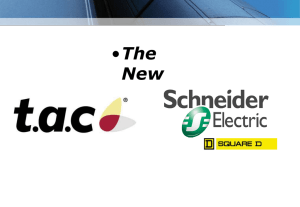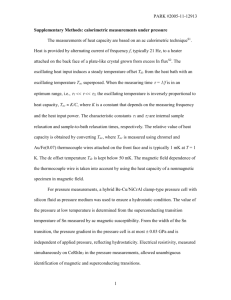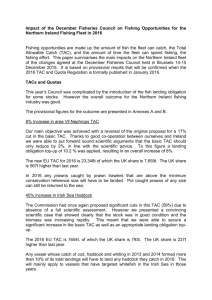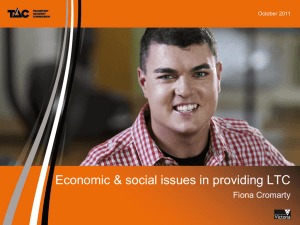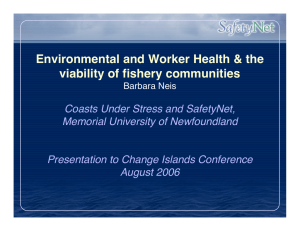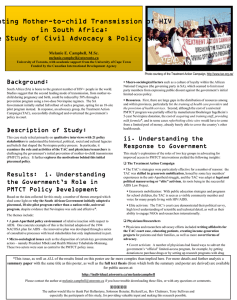International Council C.M.1996/P: 15 for the Exploration Management faced with
advertisement
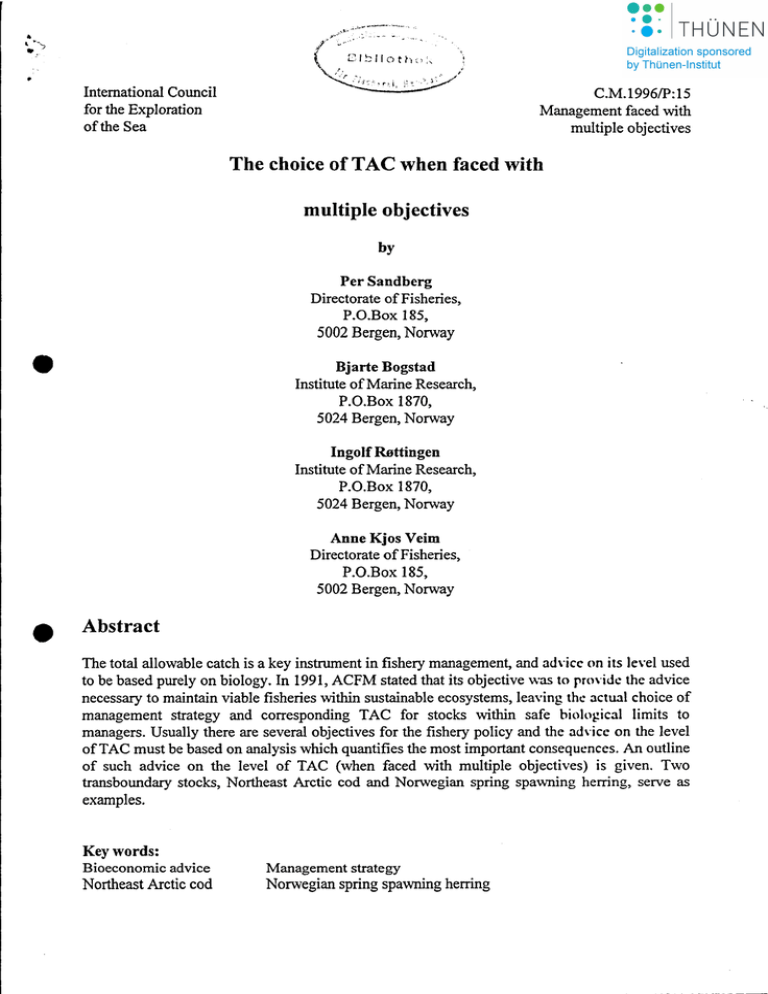
•
International Council
for the Exploration
ofthe Sea
C.M.1996/P: 15
Management faced with
multiple objectives
The choice of TAC when faced with
multiple objectives
by
Per Sandberg
Directorate ofFisheries,
P.O.Box 185,
5002 Bergen, Norway
•
Bjarte Bogstad
Institute of Marine Research,
P.O.Box 1870,
5024 Bergen, Norway
Ingolf Rattingen
Institute of Marine Research,
P.O.Box 1870,
5024 Bergen, Norway
Anne Kjos Veim
Directorate of Fisheries,
P.O.Box 185,
5002 Bergen, Norway
Abstract
The total allowable catch is a key instrument in fishery management, and advice on its level used
to be based purelyon biology. In 1991, ACFM stated that its objective was to providc thc advice
necessary to maintain viable fisheries within sustainable ecosystems, leaving thc actual choice of
management strategy and corresponding TAC for stocks within safe biological limits to
managers. Usually there are several objectives for the fishery policy and the advice on the level
ofTAC must be based on analysis which quantifies the most important consequenccs. An outline
of such advice on the level of TAC (when faced with multiple objectives) is given. Two
transboundary stocks, Northeast Arctic cod and Norwegian spring spawning herring, serve as
examples.
Keywords:
Bioeconomic advice
Northeast Arctic cod
Management strategy
Norwegian spring spawning herring
•
/~)
1.
Introdtiction
To reach the objectives of a fishery policy, a number of regulatory measures are applied. The
most comriion are input regulations (licenses, participation rights, days at sea, ete.), output
regulations (total allowable eatch, vessel quota) and various technical regulations like minimum
catching sizes, mesh sizes, closed areas or seaSons. For each management issue it is the managers
job to: .
- identify the objectives for the fishery policy relevant for the management issue
- identify the necessary means to achieve these objectives
- enforce the chosen means
•
In this paper, the management issue of fixing the yearly level of total allowable catch (TAC) is
discussed. HistoricaIly, the answer to this question was sought entirely from the profession of
marine researchers, in the coastal countries of the Northeast Atlantie usually from the
International Council for the Exploration ofthe Seas (lCES). For the most important fish stocks
it
ä tradition ,that ICES' Advisory Conimittee on Fisheries Management (ACFM) provided
an advice on TAC. The basis for such advice was usually a maximum sustainable yield
philosophy.
was
That process was altered when ACFM (1991) stated that its objective \vas to: ''prollide the advice
necessary to maintain viablefisheries u'ithin sustainable ecosystems". In order to reach such an
objective, ACFM explained that ''for stocKS which are below Afinimum Biological Acceptable
Level (AfBAL) or expected to become so in the near future" it would "in so Jar as possihle give
advice on what measures are needed to rectify the situation". For "stocks not in imminent danger
oJJalling belOlv the AfBAL" it "would provide options together with impact statements Jor each
optionl,~
Through this statement, ACFM pointed out that it wouId not provide specific advice on TAC for
stocks within sare biologieallimits2• Under such circumstances, the choice of TAC shouid be
based on objectives stated by the "owriers" ofthe resource Le. by the fishery managers.
To meet the position of ACFM, managers should have a way of analysing the consequences of
different management strategies and eorresponding levels of TAC on the most importarit
objectives. In the following, an outline of our experience from giving advice on the level of TAC
taking into aecount a fishery policy with conflicting objectives is given.
In this paper, the phrase safe biological limit is used synonymous with the phrase Minimum Biologicai
2
Acceptable Level (MBAL).
.
As an example, ACFM's management advice fer Nerwegian spring spawning herring far 1996 was:
"ACFM advises that the fishery on this stock should be managed to ensure that the SSB is kept above the
MBAL of2.5 million t." (Anen 1996c).
2
•
2.
Material and methods
As examples, the choice of TAC for two transboundary stocks, Northeast Arctie cod and
Norwegian spring spa\ming herring, will be used. Relevant literature on the biology, assessmerit
and management of the Northeast Arctie cod stock is given in Anon (1996a) and Jakobsen
(1993). Literature on the Norwegian spring spa\ming herring is given in Anon (1996b) and
Hamre (1989).
2.1
Management objective relevant for the choice ofTAC
Multiple objectives are a common feature for the fishery policy ofmany nations. The objectives of
the Norwegian fishery policy have been outlined in several white papers and are often formulated
as folIows:
•
* The existing pattern ofsettlement shall be maintaincd
* Marine resources shall gin sustainable yiclds
* People shall ha\'e secure and good jobs
* The value-added in the fisheries sector shall be increased
For many management issues, these objectives are non-compatible. This can be illustrated by the
following examples: A program to reduce overcapacity in the fishing fleet (input regulation) will be
beneficial according to the 4th objective mentioned above, \vhereas it may not be beneficial to the
1st objective. Another example may be the distribution of anational quota to either a large or a
small number offishermen, which would stimulate the 1st and the 4th objective respectively.
Conceming the management issue discussed in this paper, a small TAC will be negative to 3 ofthe
4 objectives stated in the short run. However, it is obvious that in order to be able to pursue the four
goals in the lang run, protection of the fish stocks against overfishing and stock decline is of vital·
importance. For several ofthe economie most important fish stocks in Norway, priority had to be
given to the objective of a stable, high and sustainable yield knov.ing that an increase in yield was
necessary in order to be able to pursue the other three goals. Therefore, a management objective in
compliance with the overall objectives ofthe fishery policy is:
The level ofTAC should aim at giving a stable and highest possible sustainable economic yield.
Such an objective is still multi-faceted in so far as the TAC should aim at stability (not too large
variations from year to year), highest possible economic yield (which in many instances are
synonymous \\ith a high TAC) and sustainability (which imply that the catch should not press the
stock below MBAL).
As advisers to the managers one must accept multiple objectives. In order to give an advice on the
level ofTAC under such circwnstances, it is necessary to:
3
e
--~--
a)
b)
c)
---------
--
--
----
-~-------------------------
quantify the consequences ofdifferent management strategies and corresponding levels of
TAC (or fishing mortality) on the different objectives as stabiIity, economic yield and
sustainability
inake a choice ofTAC based on the outlined consequences.
give an advice to managers on levels ofTAC and clarify its consequences.
For transboundary stocks, the actual decision on the level of TAC is taken as an integral part of
fishery negotiations between the parties concerned. As each party may have different objectives for
their fishery poIicy, it should not come as a surprise that they may differ in opinions regarding the
level of TAC. However, the advisory process described above may clarify which consequences
alternative TACs will have for the fulfilment of each party's objectives, and as such be instrumental
to reach a compromise solution.
•
To carry out analysis ofthis kind it is important to keep in mind the status which lCES possess as a
neutral biological adviser to all management authorities in the region ofthe Northeast Atlantic. This
fact implies that bioeconomic analysis undertaken to outline different consequences must be
compatible with lCES stock assessment and prognosis. When giving advice on the level of TAC
under such conditions, it is oUf experience that a co-operation between economists working in the
management, in the universities and biologists with up-to-date knowledge of leES' stock
assessments has been rewarding.
A description of biological and economic models and data applied to describe the consequences of
different levels ofTAC for the two stocks follows below.
2.2
Length of the forecast
Although the decision on the level of TAC is a yearly event, it has lang term consequences. For
Northeast Arctic cod we have calculated consequences for aperiod of 5 years. For Norwegian
spring spawning herring, consequences for a 10 year period were calculated. The longer time
horizon applied for herring was caused by the recruitment pattern ofthis stock (see seetion 2.5.3).
e
2.3
Biological model
The usual VPA-type age-structured population model is used:
Ar
JVy + 1,0 + 1
= JVY,oe-Zy..
Ar
where
y: year
a: age (years)
4
Ny,a :
Number of fish of age a at the start of year y.
F;"a : Fishing mortality rate
My,a :
Natural mortality rate
Zy,a :
Total mortality rate
Cy,a :
Catch in numbers.
The total catch in weight (TAC) in year y is then given by
•
a
Spawning stock biomass is given by:
SSBy =
I
Ny, aWSy,aOy, a
a
where
WCy,a: Weight offish at age a in the catch in year y
WSy,a: Weight offish at age a in the stock in year y
Oy,a:
Maturity ogive (proportion offish at age a which is mature in year y)
•
In order to separate the effect of the selection pattern from the effect of the overall fishing
pressure, we define
where
Sy,a : Selection pattern
/y : reference fishing mortality
The selection pattern is usua11y scaled in such a way that
a2
LSy,a
--=a~=::..:al_ _
=
1
a2 - al-l
5
•
,,
The reference fishing mortality is then equal to:
02
Fy,al-a2= 02-~1-1
0=02
L:Fy,o
=
02-~1-l
0=01
L/;Sy,O =
fy
0=01
Ibis is denoted by F later in the paper. For cod, an age range (al-a2) from 5-10 is used for the
reference mortality, while for herring, age 5-13 is used.
2.4
Economic models
As the specification ofharvesting costs generally differ between a demersal and a pelagic fishery,
different economic models were applied for Northeast Arctic cod and Norwegian spring
spawning herring.
•
Northeast Arctic cod
Price is given as average price per kg, whereas costs are given as a function of fishing rnortality:
C(F)= a+ßF
where:
•
C
:variable costs per fishing mortality
a
:constant
ß
:coefficient
Norwegian spring spawning herring
Costs are given as an average cost per kg, whereas prices are given as a function of quantity landed.
P --Pmin+ e a*TAC·
ß
where:
P
:price per kg catch
Pmin
:rnmunum pnce
a
:constant
-ß
:coefficient
..
.
6
2.5 Biological data
Both the stock size for the initial year and the fishing pattern, growth, natural mortality,
maturation and recruitment (not for herring) in the years to come were taken from the last ICES
Working Group reports (Table 3.23 in Anon, 1996a for cod and Table 3.5.12 in Anon, 1996b for
herring).
2.5.1
Fishing pattern
For herring, a fishing pattern giving fuH recruitment to the fishery at age 5 is used. For cod, the
average selection pattern for 1992-1994 is used in the predictions. This pattern implies that the
eod is fuHy reeruited to the fishery at about age 6.
2.5.2 Growth
The growth of Northeast Arctic cod is very variable and this has eaused problem for the
management of this stock (Mehl, 1991). The growth is closely eorrelated with the variations in
abundance of capelin, the most important prey for cod. The weight at age from 1996 onwards is
assumed to be equal to the average ofthe period 1987-1990, when the capelin stock was at a very
low level. The capelin stock is eurrently at a similar low level and is expected to remain at such a
level at least until 1998.
•
The Norwegian spring spawning herring is feeding on plankton and weight at age will generally
not differ as much as for cod. In the prognosis, the average weight at age for the 1960s was used
for 1997 onwards.
2.5.3 Recruitment at age 3
In the biological model, age of recruitment to the stock is usually defined as the age at which the
fishery starts (eurrently age 3 is used for both Northeast Arctic cod and Norwegian SpringSpawning Herring).
A long term analysis of biological and economic consequences of different levels of exploitation
will to a great extent depend on the size of the recruiting year classes. The approach taken when
giving a prognosis on recruitment was to investigate:
- time series of recruitment
- the reeruitment's dependence on spawning stock
- prognosis on predation on fish not yet recruited to the fishable stock
- prognosis on oceanographic conditions relevant to recruitment
Time series of recruitment show high variability for both stocks. For Northeast Arctic cod, the
recruitment was set equal to the average of the 1943-1991 year classes. For Norwegian springspavvning herring, the stock development depend very strongly upon a few strong year classes.
There seem to be typically 8-10 years between strong year classes. Several models for stockrecruitment relationship have been proposed and are under investigation by the leES AtlantoScandian Herring, Capelin and Blue Whiting Working Group (Anon 1996b).
7
•
In order to illustrate the eonsequenees of at what time the riext strong year dass oecur in a
simpler ,way thari thfough a risk analysis, simulations were nin \vith a high recruitrrient (24
billion, eqUal t~ the 1992 year daSs), occumng either in year 1998 or in year 2000. For the other
years, the recrUitrrient was asstimed to be low (845 million, eqllaI to the 1994 year dass).
2.5.4 Natural mortality , age 3 and older
For Northeast Arctie cod M was set to 0.2 for all ages and years, whereas for Norwegian Spring
Spawning Herring, M was set to 0.13.
2.5.5 l\faturity ogive
•
v.
For Northeast Afetie eod, a maturity ogive equal to the average for the period 1993-1995 was
used. For Norwegian spring-spawiüng hemng, a maturity ogive equaI to the average for 19601968 was used for 1997 onwards. The ogive indieate that herring on average reeruit to the
spawning stock at age 5 and cod at age 7.
2.6
Economic data
In the fishery for cod, trawlers and vessels fishing v.ith nets, long line and Danish seme participate.
Data on costs representative for these vessel gi-oups were drriwn from the NOlviegian profitability
analysis (Fiskeridirektoratet, 1995a), whereas data on eamings\vere dra\w from the Norwegian
fishery statistics. In the fishery for herring, purse seine and trawl are the most common gear. Datei
on eosts were drav.n from the vessel group landirig the majority of the catch, the licensed purse
seiners (Fiskeridirektoratet, 1995b).
When eaieUlating the eeonoritie benefits from fisheries, one should ideally obtain estimates of tbe
value ofthefmal cod products consumed by the population ofNorway or eXported, as weH as the
costs offishirig, transporting and proeessing ofthe eatcil. Net econoinie benefitS would then accrue
as total revenue less all costs involved.
•
So far, calculations have been erirried out to establish revenues and costs iri the processing of eod
(Fiskeridirektorntet 1995a) and herring (Fiskeridirektoratet 1995b). However, these estimates of
revenues and costs in the proeessing industry have yet not been found to be representative enough
to use them in a bioeeonomie analysis of this kind. Consequently, our approach hitherto has not
reached a level where the net econorillc benefits to the Norwegian society could be calcUlated.
Iostead we have focused upon the economie benefits at the level ofthe Norwegian fishing fleet, and
in the foIlowing \ve \viIl sketch out how this benefit has been calculated.
2.6.1
Revenues
Revenues, or ineome, have been founrl as the share of the TAC which accrue to Norwegian
fishennen times price obtairled for the fish. Time series were analysed in order to find a long tenn
trend in priees or whether prices correlated with the size of the Norwegiari catch. For Noftheast
AIetie eod no trend during years or eorrelation between priee or the size of the Norwegian catch
",'as fou.nd (Fiskerldirektorntet, .1995a).
a prognosis for future price, the average priee for the
period 1989 - 1994 was used (Fiskeridirektoratet, 1995a).
As
8
5
For Norwegian spring spawning herring, a relationship between total catch and price was estimated
using data from the period 1980-1993 (Bogstad et al, 1994 and Fiskeridirektoratet, 1995b).
2.6.2
Costs of fishing
Data on costs and earnings were taken from the profitability survey ofNorwegian fishing vessels in
1994 (Budsjettnemnda 1994). Total costs of fishing were divided into fIXed and variable. These
have been treated as folIows:
Fixed costs
Fixed costs are costs occurring irrespective of the activity or the catch level of the vessels.
Concerning the question of fIXing the level of TAC and the consequences of different levels of
TAC during aperiod, the fixed costs are necessary for determining the economic benefit or
profitability ofthe fishery. However, as the fIXed costs occur irrespective ofthe size ofthe TAC,
they are not relevant when calculating which TAC yields maximum economic benefit, unless there
exists a relationship between the size ofTAC and investment in the fishing fleee.
•
As we have not yet found any empirical relationship bet\veen the size of the TAC and investment,
our approach has been to exc1ude fixed costs from the analysis. Trus implies that the economic
benefit we calculate is equal to the contribution margin, that is revenue less variable costs.
Variable costs
In demersal fisheries, it is common to assume that some of the variable costs depend upon the size
ofthe fishable part ofthe stock. The llOderlying logic for such assumption is that when the stock is
small, a larger effort will be needed to catch a given quantity of fish than when the stock is large
(Clark, 1976).
Trus assumption is not made in pelagic fisheries, as most pelagic fish are "schooling". targeted by
sonar equipment. Trus implies that effort needed to catch a given quantity of fish may not be
significantly higher when the stock is small than when the stock is large.
Consequently, for the Northeast Arctic cod, variable costs (ex labour costs) arc ä priori assumed to
depend upon the stock size. Costs components c1assified to be variable \\cre laken from
profitability survey for Norwegian fishing vessels in 1994 (Budsjettnemnda 19(4). In the
profitability survey these constitutes labour costs, fuel, product tax and expcmiiture to cooling,
salting and packing the catch, and are labelIed R.2.01-R.2.04 and R.2.10 in thc profitability
analysis. In the profitability analysis, these costs are given as average costs per ,"essel. l11c cost per
fishing mortality were simply found by multiplying the cost per vessel ,vith the number of vessels
needed to exercise a certain level of fishing mortality. A further discussion of the method can be
found in Nakken et al (1994) and Steinshamn (1993).
3
In the long nm, it is reasonable to believe that investment in the fishing fleet will depend upon the level of
TAC. Rational investors will adjust the investment in order to achieve as high a profit as possible, and a higher
level ofTAC may therefore also give higher investment and flXed costs in the long nm.
9
•
t
U
For the Norwegian spring spawning herring, variable costs are only assumed to depend upon the
catch level. The same cost components were taken from the most important vessel group (the
licensed purse seiners) and tising data from the period 1982-1992, a relation between quantity and
price was found (Bogstad et al, 1994).
2.6.3
Discount rate
This year's TAC have a larger value than future TAC's since net revenue from catches this year
can be invested and give a rate ofreturn. To adjust for this we reduce the net revenue from future
TAC by a factor that reflects the rate of return in the market, i.e. the discount rate. When
discounting we use a rate of 5%.
•
The decision on the yearly level of TAC is adecision of how much of a resource should be used
now versus in the future. According to an objective of sustainability, one might ask whether
discounting can be justified. In the results, we therefore calculate both discounted and undiscounted
revenues.
2.7
Uricertainty
Data applied will be subject to various levels of uncertainty. Consequences of different
management strategies and corresponding levels of TAC should therefore in principle only be
presented according to a certain level of probability. An example of a risk arialysis for Norwegian
spring spawning herring undertaken by Anon (l996b) is described under section 3.2.
In order to combine economic and biological data, a simplified approach was used. The
management advices described in this paper was therefore based on a deterrninistic approach. As a
consequence, uncertainty inherent in data were not dealt with.
.
3~
Resrilts
,
.
The model and data as specified above v,"ere used for the tv..o stocks mentioned, and tables 1-4
show the results. For Northeast Arctic cod different levels of fishirig mortality during a five year.
period were analysed. For Norwegian spring spav,ning herring, scenarios were run to compare a
flXed TAC-strategy with a fixed F-strategy. After finding that a fixed TAC-strategy, according to
the objectives of the fishery policy, was better than a fixed F-strategy, diffe.rent levels of fixed
TACs were run.
As our objective was that the leyel ofTAC should be fixed in order to give a stable, sustainable and
highest possible economic yield, we calcUlated the consequences which different levels of fishing
mortality or TAC had on spawning stock arid on economic parameters as average gross and net
revenues as weIl as the net present value of catch during aperiod.
10
3.1
Nortbeast Arctic cod
Tables 1 and 2 beIow show the biological and economic consequences of different levels of
fishing mortalities.
Table 1. Biological consequences of different levels of fixed fisbing mortalities during the period 1996-2000.
Biomass and catcbes given in thousand tonnes.
Management strategy
for the period
1996 -2000
TAC for
1996
Average
TAC
Minimum
levelof
spawning
stock
Spawning
stock
year2001
F=0,55
F=0,46
F=0.40
F=0,37
F=0,32
797
694
620
580
517
672
640
612
594
561
518
683
697
697
697
552
733
893
996
1179
c
•
The TAC for Northeast Arctic cod for 1995 was 700 000 tonnes. The objective calling for
stability, indicated that the TAC for 1996 should not deviate too much from that level.
Both Jakobsen (1993) and Nakken et al (1994) argues that a spawning stock of 500 000 tonnes
should be seen as a limit reference point, beneath which managers should attempt not to bring the
stock. Table 1 shows that the minimum level of spa\\ning stock is far above this level for fishing
mortalities in the range from 0.32 to 0.46, but very elose when a fishing mortality of 0.55 is
exercised. Furthermore, a lower fishing mortality will yieId a higher spa\\ning stock at the end of
the period (year 2001).
In order to achieve a sustainable harvest, the stock should not be brought elose to its limit
reference point. Consequently, a fishing mortality of 0.55 should be ruled out. A fishing
mortality of 0.40 would harvest the stock more conservatively than a fishing mortality of 0.46 as
the spawning stock in the end of the period is forecast to be 160 000 tonnes higher. However,
such a reduction would also imply a lower average TAC. Table 2 shows the economic
consequences ofthat.
Table 2. Economic consequences of different levels of fixed fishing mortalities during the period 1996-2000.
Catches given in thousand tonnes. Values based on a Norwegian share ofthe TAC at 45% and is given in
million NOK. Discount rate = 5%.
..
c
Management strategy
for tbe period
1996 -2000
AverageTAC
c
F=0,55
F=0,46
F=0,40
F=0,37
F=0,32
672
640
612
594
561
Anrage gross
revenue for
Norwegian
fishing fleet
2123
2023
1934
1876
1773
Average net
re\'cnue for
Norwegian
fisbing fleet
826
832
823
812
786
Net present value
of catcb from tbe
whole period
(discounted)
3780
3788
3732
3676
,
·3549
11
e
t
'.l
Not surprisingly, the average gross revenue is higher the higher fishing mortality. Due to the
density-dependent harvesting costs, the average net revenue is lower when the fishing mortality
is increased from 0.46 to 0.55. There is therefore no economic rationale in choosing the highest
fishing mortaIity. Concerning the objective of highest possible economic yield, Table 2 shows
that this will be almost identical for fishing mortaIities in the range 0.32-0.55.
Taking account of tbe tbree objectives discussed above, our advice was tbat a fisbing
mortality of 0.40 during tbe period 1996 - 2000 would be beneficial. Such a fishing
mortality would yield a TAC of 620 000 tonnes in 1996.
The actuaI TAC for 1996 was fixed at 700000 tonnes.
3.2
Norwegian spring spawning herring
Since the collapse of this stock in the 1960s, the stock has been managed in order to achieve a
limit reference point of 2.5 million tonnes. The spawning stock biomass is now weIl above that
level.
A risk analysis, focusing on the uncertainty in recruitment ofherring, and the effects of different
harvesting strategies were carried out by Anon (1996b). Figure 1 is drawn from that analysis, and
shows the results of the simulations giving the development of SSB during a 10-year period
according to different levels of probabilities. In the upper frame, this development is shown for a
constant F-strategy and in the lower frame it is shown for a constant TAC strategy. Both
strategies yield total catch of approximately 10 million tonnes during the whole period.
12
t
Figure I. Simulated development of SSB according to different levels of probability. The upper frame shows a
.
constant F-strategy and the lower frame a constant TAC-strategy. Drawn from Anon (1996b).
Constant F, recruibnent model 1
20 ~~~~~~~~~~=~-===-:':':~~~~~~
18
16
14
--5%
--25%
12
10
~.~~m
4
2
-50%
--75%
:~::::~::~;~;~&t1*11~~~~~~t1~~~~1;i~j~ji~~;~~~t~M~~;~;~;~§:~:~:~~~~:~~;:::;:;:.:.;.;. .
:t;:m:;~t;;:~f~~:l~~iili~r~1:fr*~~;~:;~fJ~rt~$~~~m~sHt0j~1I:~i~t~~~M~f~~r::~tmft~~:~;~;~::~~:~·~:~?~~~~~~·~·;·:: : ·: :~:~: ~{;: :~i:'~ .;:.:.:';~: '. :~: ':': :'.: .:~
O~=~==~=~==!'=======~===~
(0
...
Cl'l
Cl'l
r;;
...
Cl'l
Cl)
...
Cl'l
Cl'l
o
8N
--95%
-MBAL
III
8N
. Constant catch, recruitment model 1
--5%
--25%
-50%
--75%
--95%
Time
I
-:--MBAL
In general the constant catch option seems to give smaller probabilities of maintaining the
spawning stock above 2.5 million tonnes. The reason seems to be that a constant F-strategy will
tend to be more conservative in a declining stock situation.
According to a precautionary approach, a constant F-strategy would therefore be preferable to a
constant TAC-strategy. However, according to the objective ofstability in yield (see section 2.1),
a constant TAC-strategy would be preferable to a constant F-strategy, see Figure 2.
13
----- -
- -
-------------
Figure 2. A fixed TAC versus a simulated development ofTAC according to a fixed F-strategy
Fixed TAC versus fixed F - good recruitment in year 2000
UI
G>
c
c
',2
.5
J:
u
'i
u
1800000
1600000
1400000
1200000
1000000
800000
600000
400000
200000
0
co
m
m
..-
--Fixed F=0.171
- - Fixed TAC =1 000 000 1.
co
I"-
0)
0)
..-
0)
0)
..-
0)
0)
0)
....
0
0
0
N
N
0
0
N
(;
0
N
M
0
0
N
..,.
10
N
0
0
N
g.
Year
Analysis carried out by Fiskeridirektoratet (1995b) showed that the difference in economic
consequences of the two different strategies were very small. The objective of stability in yield
therefore implied that a constant TAC-strategy was recommended.
Having established that a fixed TAC strategy was preferable to a fixed F strategy, we evaluated
the level of a flXed TAC which could be recommended, using a deterministic model. Table 3 and
4 shows the most important consequences of different levels of TAC, according to different
assumptions on the timing ofnext strong year class.
e
Table 3 Economic and biological consequences of different levels of TAC if the next strong ~'ear dass (equal
to the 1992-cohort) occur in )'ear 2000. Biomass and catches given in thousand tonnes. Values based on a
Nom'egian share of 100% ofthe TAC and given in million NOK. Discount rate =5%. Prices in 1992 NOKlkg
Yearly level
ofTAC for
the period
1996 - 2005
Average
price
Average
gross
rennue
Average
oet .
revenue
600
1,26
753
344
Net prescot
value of catch
from the ",hole
period
(discounted)
2788
700
1,23
859
381
3097
-
4300
800
1,21
964
419
3400
-
3800
3300
NOKikg
-
Yearwheo
spawning stock
fall below 2.5
million tonnes
Lowest
• levelof
spawning
stock
-
4800
900
1,19
1069
456
·3700
1000
1,17
1174
493
3995
-
1100
1,16
1278
529
4288
2004
2200
1200
1,15
1381
565
4579
2003
1700
2700
14
(
Table 4 Economic and biological consequences of different levels ofTAC if the next strong year dass (equal
to the 1992-cohort) occur in ~'ear 1998. Biomass and catches given in thousand tonnes.• Values based on a
Norwegian share of 100% of the TAC and given in million NOK. Discount rate = 5%. Prices in 1992 NOKikg
Average
price
Average
gross
rel'enue
Average
net
revenue
Yearwhen
spawning stock
fall below 2.5
million tonnes
Lowest
levelof
spawning
stock
6700
600
1,26
753
344
Net present
value of catch
from the whole
period
(discounted)
2788
700
1,23
859
381
3097
-
800
1,21
964
419
3400
-
5800
900
1,19
1069
456
3700
5400
1000
1,17
1174
493
3995
1100
1,16
1278
529
4288
-
4400
1200
1,15
1381
565
4579
-
3800
1300
1,14
1486
600
4868
3200
1400
1,14
1589
636
5155
-
Yearly lenl
ofTAC for
the period
1996 - 2005
NOKikg
6300
4900
2600
Table 3 shows that if the next good recruitment comes in year 2000, it is possible to keep a
constant TAC at 1 million tonnes during the period 1996-2005 without bringing the stock down to
its limit reference point. However, if the next good recruitment comes as early as in year 1998
(Table 4), it is possible to keep a constant TAC at 1.4 million tonnes without bringing the stock
dO\\TI to its limit reference point.
As these are results of a deterministic model which do not explicitly state the probability, a
precautionary approach ,,"ould suggest lower levels 6fTAC than stated above.
I
As mentioned earlier, no density dependent harvesting cost are applied when calculating the net
economic benefit for a pelagic species as herring. A high TAC \\i11 therefore satisfy the objective of
a bigbest possible economic yield, only modified slightly by a lower price.
According to the objective ofstability, we have advocated a strategy based on constant TAC for a
number of years. Taking also account that such a level of TAC should be compatible with the
objective ofsustainabiIity, the TAC could not be too high.
Taking account oftbe tbree objecth'es mentioned above, and tbc uncertainty ofwhen tbc next
strong }'ear class will occur, our advice was that managers should adopt a management
strategy of a f"IXed TAC at about 800000 - 1 000000 tonnes per }'ear. A TAC in the lower
region or this interval would be more precautionary than a TAC in the upper level.
Four coastal nations decided upon a TAC at approximately 1.1 million tonnes for 1996. As the
stock is available for catch in international waters the actual catch may be higher than this.
15
"
"
•
4.
Discussion
ACFM's 19~I-statement of its objectives implies timt managers must consider non-biological
arguments when choosing levels of TAC and management strategies for different stocks. \Vhen
multiple objectives characterise the fishery policy, it is also themanagers job to identify which
objective will be most affected by different choice of management strategy, and thereafter work
to\\ards a management strategy that accomplishes the given objectives in the best way possible.
Our experience so far indicate that:
I. .
Multiple objectives cannot be reduced to one objective.
2.
Adviee on the level ofTAC when faeed with multiple objeetive must be based on a
quantification ofthe eonsequences whieh that TAC has on the different objectives.
3.
For transboundary stocks, bioeconomic analysis leading to advice on the level ofTAC to
one ofthe management authorities should be based on stock assessment and prognosis
provided by ICES and controlled by ACFM.
The process of communicating the associated risk with management strategies and levels ofTAC is
in its early stages and presents considerable challenges to both fishery scientists, economists and
managers (Caddy and Mahon, 1995).
In Norway, this process of giving advice on the level of TAC has just started. Future work to
improve the quality of these arialysis include - inter aHa -, investigations on gear selectivity,
multispecies analysis, further work on price-quantity relationships, estimation of processing eosts
and how harvesting costs depend upon the size ofthe various fish stocks.
Furthermore, the corisequenees ofuncertainty in various parameters should be given treatment. The
managers should stimulate the process of applying risk analysis whieh shows the potential cost of a
management strategy which brings a stock below the MBAL level, as weIl as foeus on analysis
showing the consequences which arise when the national share of a TAC vary according to the size
ofa fish stock.
To meet the challenge by ACFM, such work should be an integral part of each nations fishery
administration. If funding of such work is not given priority, it should be considered whether
ACFM should return to its former practice of giving fmn advice on the level of TAC, irrespective
o~the biological status ofthe stocks.
.
References
ACFl\f, 1991: Extraet ofthe report ofthe Advisory Committee on Fisheries Management to the
Nortb-East Atlantic Fisheries Commission.
16
I
Anon, 1996a: Report ofthe Arctic Fisheries Working Group. ICES, Copenhagen, 23-31 August
1995. ICES C.M. 1996/ Assess: 4.
Anon, 1996b. Report ofthe Atlanto-Scandian Herring, Capelin and Blue Whiting Assessment
Working Group. Bergen 12-18 October 1995. ICES CM 1996/Assess: 9.
Anon, 1996c. Report ofthe ICES Advisory Committee on Fishery Management. ICES Cooperative Research Report no 214. Copenhagen 1996.
Bogstad B., Rottingen J., Sandberg P. og Steinshamn S.I., 1994. Beskatningsstrategi for norsk
värgytende sild. Stiftelsen for samfunns og nreringslivsforskning. Rapport 84/94. In Norwegian.
Budsjettnemnda 1994. Lonnsomhetsundersokelser for fiskefartoyer 13 m.l.l. og over.
Fiskeridirektoratet. In Norwegian.
Caddy,J.F. and Mahon,R.1995. Reference points for fisheries management. FAO Fisheries
Technical Paper no 347. Rome 1995.
•
Clark, 1976. Mathematical bioeconomics. John \Viley and sons, New York
Fiskeridirektoratet, 1995a. Rapporter og meldinger, nr 4. Beskatningsstrategi for norsk arktisk
torsk. In Norwegian.
Fiskeridirektoratet, 1995b. Rapporter og meldinger, nr 3. Beskatningsstrategi for norsk
värgytende sild. In Norwegian
Hamre J. 1989. Life history and exploitation ofthe Norwegian spring spa\,ning herring. In
"Biology and fisheries ofthe Norwegian spring spawning herring and blue whiting in the
Northeast Atiantic." Proceedings ofthe fourth Soviet-Norwegian Symposium. Bergen, 12 - 16
June 1989. Institute ofMarine Research, Bergen
Jakobsen T. 1993. Management ofthe North-East Arctic Cod - past, present and future? Pp. 321338 in Proceedings of the International Symposium on Management Strategies for exploited fish
populations, Alaska Sea Grant College Program, AK-SG-93-02
Mehl, S. 1991. The Northeast Arctic stock's place in the Barents Sea ecosystem in the 1980s: an
overview. Polar Research, 10(2): 525-534.
Nakken 0., Sandberg P. and Steinshamn S.I. 1994 Management strategies for the Northeast
Arctic cod stock. \Vorking paper No 96/94. Centre for Research in Economics and Business
Administration, Bergen.
Steinshamn, S.1. 1993 Torsk som nasjonalfonnue: En disaggregert modell. SNF-rapport nr
61/1993. Stiftelsen for samfunns- og nreringslivsforskning. Bergen. In Norwegian.
I
I.
17

